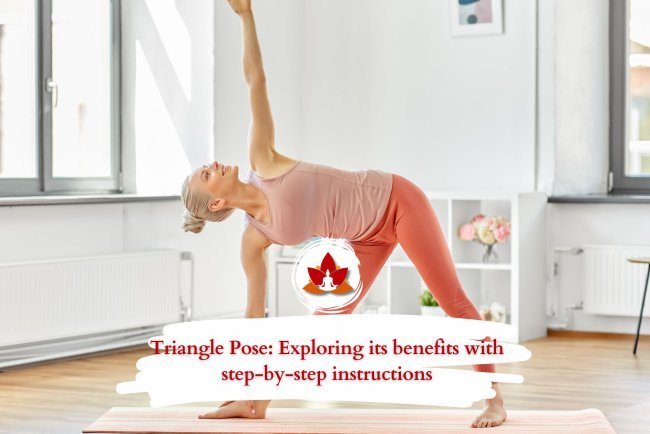How To Do Bridge Pose? And Its Benefits?

Bridge Pose, known as Setu Bandhasana in yoga, involves lying on your back, bending your knees, and lifting your hips upward. This pose strengthens your back muscles, stretches the chest, neck, and spine, and improves overall flexibility. It's often practiced for its ability to relieve stress and calm the mind. Bridge Pose is accessible for most practitioners and can be modified with props like blocks for support. Incorporating this pose into your yoga routine can contribute to both physical strength and mental relaxation.
Steps To Do Bridge Pose
-
Start by lying on your back,arms alongside your body, palms facing down.
-
Bend your knees, feet flat on the floor, hip-width apart, heels close to your sitting bones.
-
Press your feet and arms into the floor, Inhale, lift your hips towards the ceiling.
-
Roll your shoulders under your body, interlace your fingers or keep arms flat, palms down.
-
Lift your chest towards your chin, keep your chin slightly away from your chest.
-
Hold the pose, breathe deeply, hold for 30 seconds to a minute.
-
Release, gently lower your hips back down to the mat, vertebra by vertebra.
5 Points To Remember Before Bridge Pose
Warm-up: Always warm up your body before attempting Bridge Pose to prevent strain.
Body alignment: Keep your feet hip-width apart and parallel, and ensure your knees are directly over your heels.
Breathing: Focus on deep and steady breathing throughout the pose.
Modify if needed: Use props like a yoga block under your sacrum for support if you find it challenging.
Avoid if injured: Skip this pose if you have neck or back injuries, or consult a yoga instructor for modifications.
3 Bridge Pose Variations and Modifications
There are a few ways to modify bridge pose:
- Use a yoga block: Support your lower back with a yoga block placed under your hips during Bridge Pose. Position the block directly under your sacrum, adjusting its height for comfort. Choose the level that feels most supportive, from low to high.
- Keep your hands on the mat: Instead of clasping your hands behind your back, keep your palms down on the ground with arms straight. This provides better support and stability while lifting your hips up high in the pose.
- Practice Eka Pada: Begin in Bridge Pose, then lift one leg off the ground while maintaining your balance and breathing steadily. Gradually try lifting the other leg to achieve symmetry and strengthen your body's stability.
10 Health Benefits Of Bridge Pose Yoga
-
Strengthens Back: Builds strength in the back muscles, improving posture.
-
Stretches Chest: Opens up the chest, promoting deeper breathing.
-
Relieves Back Pain: Alleviates mild back pain by strengthening the spine.
-
Improves Digestion: Stimulates abdominal organs, aiding digestion.
-
Calms the Mind: Helps reduce stress and anxiety levels.
-
Enhances Flexibility: Stretches the neck, chest, and spine, increasing flexibility.
-
Reduces Fatigue: Boosts energy levels by increasing circulation.
-
Helps Insomnia: Promotes relaxation, aiding in better sleep.
-
Tones Legs and Glutes: Strengthens and tones the legs and buttocks muscles.
-
Improves Blood Circulation: Enhances blood flow throughout the body, supporting overall health.
Conclusion
Bridge Pose (Setu Bandhasana) is a transformative yoga posture that strengthens the back, tones the body, and increases flexibility. By opening the chest and shoulders, it improves breathing and posture. This pose not only enhances physical health by alleviating back pain and boosting circulation but also promotes mental calmness and reduces stress. Regular practice can help achieve better overall well-being, making it a beneficial addition to any yoga routine. Enjoy the benefits of improved strength, flexibility, and inner peace with Bridge Pose, embracing its holistic impact on body and mind.
Frequently Asked Questions
Q. What is the purpose of bridge pose?
Bridge Pose strengthens the back, opens the chest, and improves spinal flexibility. It enhances core stability, relieves mild back pain, promotes relaxation, and boosts circulation for overall physical and mental well-being.
Q. What is bridge pose called in Sanskrit?
Bridge Pose is called "Setu Bandhasana" in Sanskrit.
Q. Who should not do bridge pose?
Avoid or adjust Bridge Pose (Setu Bandhasana) if you:
-
Have neck, shoulder, or back injuries.
-
Feel severe back pain.
-
Recently I had abdominal surgery.
-
Have high blood pressure or heart issues (without adapting).
-
Are pregnant, especially in later stages (without adapting).
Q. What are the modifications for Bridge Pose?
Using a yoga block: Place a block under your sacrum for support and reduced strain on the lower back.
Q. Can we do bridge pose during periods?
Bridge Pose (Setu Bandhasana) can be done during periods, but it's important to adjust according to how you feel. Many women find it helpful for easing menstrual cramps and promoting relaxation. If you feel uncomfortable or tired, it's okay to skip or modify the pose to suit your needs. Listen to your body and practice in a way that feels right for you during your period.
What's Your Reaction?


























